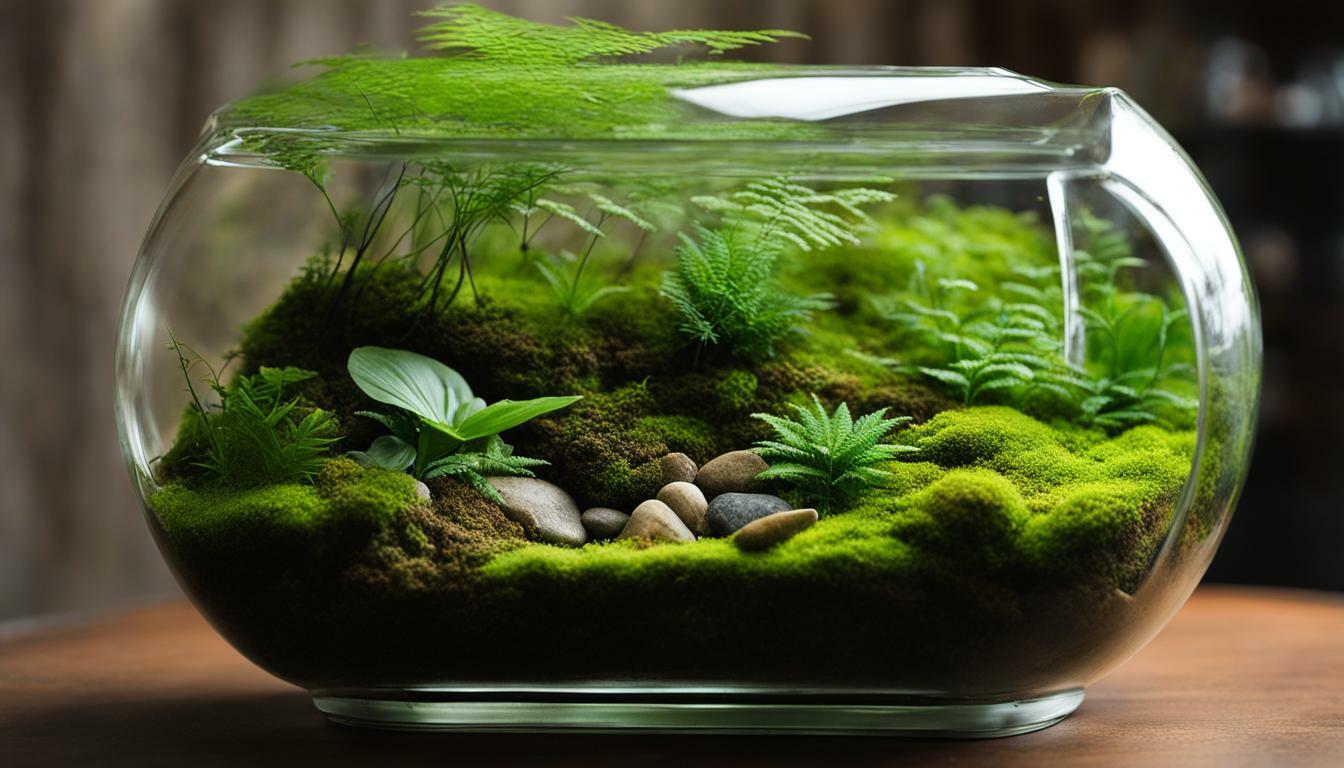Are you ready to unleash your creativity and bring nature indoors with DIY terrariums? Creating a DIY terrarium is a fun and easy way to add a touch of greenery to your living space. By following a few simple steps, you can create your own miniature world filled with lush plants and a unique sense of tranquility.
To start, select a glass container with a wide opening, ensuring it is clean and ready for your terrarium. The glass container provides a clear view of your miniature world and allows natural light to reach the plants. Remember, the right container is the foundation for your terrarium’s success.
Once you have your container, begin building the layers for a healthy terrarium. Start with a drainage layer of stones or rocks at the bottom to prevent water from pooling. Next, add a layer of activated charcoal, which will absorb excess moisture and keep your terrarium fresh. Wet some moss and place it on top of the charcoal to act as a barrier, preventing water overflow and maintaining the right moisture balance for your plants.
Now it’s time to add the soil where your plants will thrive. Choose the appropriate soil type based on the needs of your plants, ensuring they have the nutrients necessary for growth. Carefully transfer your selected plants into the terrarium, arranging them to create an aesthetically pleasing composition. Add more soil around the plants, making sure they are secure and have room to grow.
Once your terrarium is complete, it’s time to unleash your creativity and add a personal touch. Consider accessorizing your terrarium with miniature figurines or other trinkets that reflect your style and create a unique miniature world. This is an opportunity to let your imagination run wild and make your terrarium truly your own.
- DIY terrariums are a fun and easy way to bring nature indoors.
- Choose a glass container with a wide opening for your terrarium.
- Create layers in your terrarium for drainage, moisture absorption, and plant growth.
- Select the right soil for your plants to thrive.
- Accessorize your terrarium to personalize your miniature world.
Why DIY Terrariums Are a Great Craft Project
DIY terrariums are not only a fun craft project, but they also allow you to unleash your creativity and create a unique piece of nature for your home. Whether you’re an experienced crafter or just starting out, terrariums offer a simple and rewarding way to express your artistic side.
One of the great things about DIY terrariums is that they can be personalized to reflect your own style and taste. You can choose from a variety of containers, plants, and accessories to create a terrarium that is truly one-of-a-kind. Whether you prefer a minimalist design with clean lines or a whimsical arrangement with colorful figurines, there are endless possibilities to explore.
Creating a terrarium is also a great way to bring the outdoors inside, especially if you have limited space or live in an urban area. By incorporating plants into your home decor, you can create a calming and refreshing atmosphere. Studies have shown that being around nature can reduce stress and increase overall well-being, making terrariums a perfect addition to any living space.
“DIY terrariums offer a simple and rewarding way to express your artistic side.”
Another benefit of DIY terrariums is that they require minimal maintenance. Once you’ve assembled your terrarium, it can thrive in its own self-contained ecosystem. With proper watering and light, your terrarium can last for months or even years with minimal effort. This makes terrariums an ideal choice for busy individuals or those who may not have a green thumb.
In conclusion, DIY terrariums are a wonderful craft project that allows you to tap into your creativity and bring a piece of nature into your home. With a wide range of design options and low maintenance requirements, they are a perfect choice for both experienced crafters and beginners alike. So why not embark on a terrarium-making adventure and create your own miniature world?
Table: Benefits of DIY Terrariums
| Benefits | Description |
|---|---|
| Creative Outlet | Create a unique piece of nature that reflects your personal style and taste. |
| Bring Nature Indoors | Create a calming and refreshing atmosphere by incorporating plants into your home decor. |
| Low Maintenance | Once established, terrariums require minimal care and can thrive in their own self-contained ecosystem. |
Choosing the Right Container for Your Terrarium
When it comes to DIY terrariums, choosing the right container is crucial for the success of your miniature ecosystem. A glass container with a wide opening is ideal, as it allows for easy access when arranging your plants and provides ample room for growth. Additionally, a glass container allows for better visibility, allowing you to fully enjoy the green world you’ve created.
Before filling your chosen container, it’s important to ensure that it’s clean and free from any debris. This will help maintain a healthy environment for your plants and prevent any potential contamination.
For added visual appeal and to protect your plants, consider using a container with unique shapes or patterns. This will not only showcase your creativity but also add an extra touch of beauty to your terrarium.
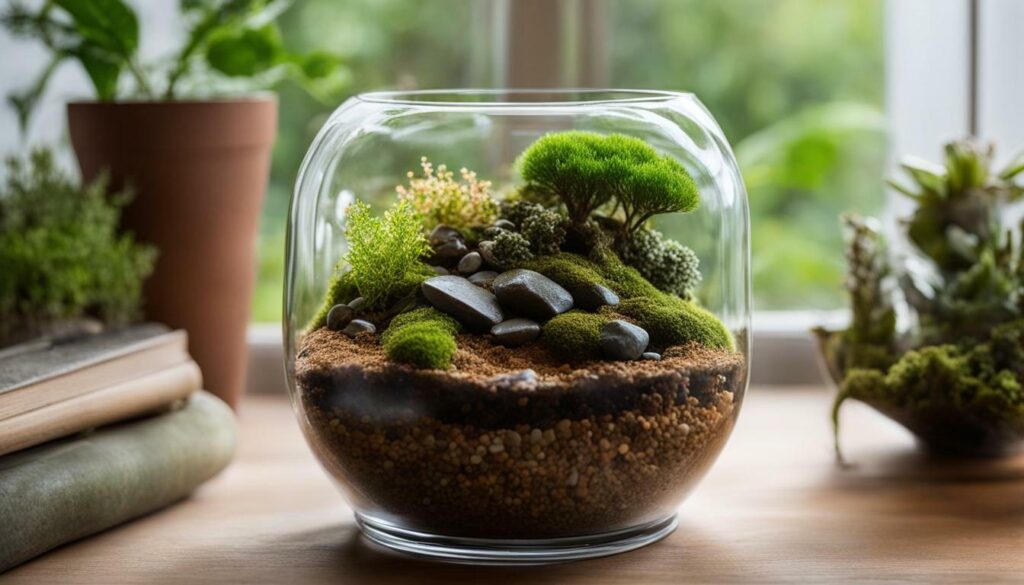
“A glass container with a wide opening is ideal, as it allows for easy access when arranging your plants and provides ample room for growth.”
In conclusion, selecting the perfect glass container is an important step in creating a successful DIY terrarium. Remember to choose one with a wide opening, keep it clean, and consider adding a unique touch to enhance its visual appeal. By following these guidelines, you’ll be well on your way to creating your own beautiful miniature world.
Creating the Essential Layers for a Healthy Terrarium
To ensure the health and longevity of your DIY terrarium, it’s essential to create the right layers that promote proper drainage and moisture control. By following these steps, you’ll be able to create an environment where your terrarium plants can thrive.
1. Drainage Layer
The first layer you’ll need is a drainage layer, which helps prevent water from pooling at the bottom of your terrarium. This layer can be made using small stones or rocks. Place a layer of about an inch or two at the bottom of your glass container. The drainage layer allows excess water to flow away from the plant roots, preventing root rot and mold.
2. Activated Charcoal Layer
Next, add a layer of activated charcoal on top of the drainage layer. Activated charcoal helps absorb excess moisture and odors, keeping your terrarium fresh and healthy. Spread a thin layer of activated charcoal evenly over the rocks. Make sure to cover the entire surface area, but avoid adding too much, as it may interfere with water absorption by the soil.
3. Moss Layer
After the activated charcoal, add a layer of damp moss. Moss acts as a barrier between the soil and the drainage layer, preventing soil from mixing with the rocks. It also helps retain moisture and prevents water from overflowing. Wet the moss slightly before placing it on top of the activated charcoal. Gently press it down to create a solid surface for the next layer.
4. Soil Layer
Finally, add a thick layer of soil on top of the moss. Choose a soil mix that is suitable for the type of plants you want to include in your terrarium. Make sure the soil is well-draining to prevent waterlogged roots. Add enough soil for your plants to firmly anchor their roots and grow. Distribute the soil evenly, leaving enough space for planting and arranging your chosen plants.
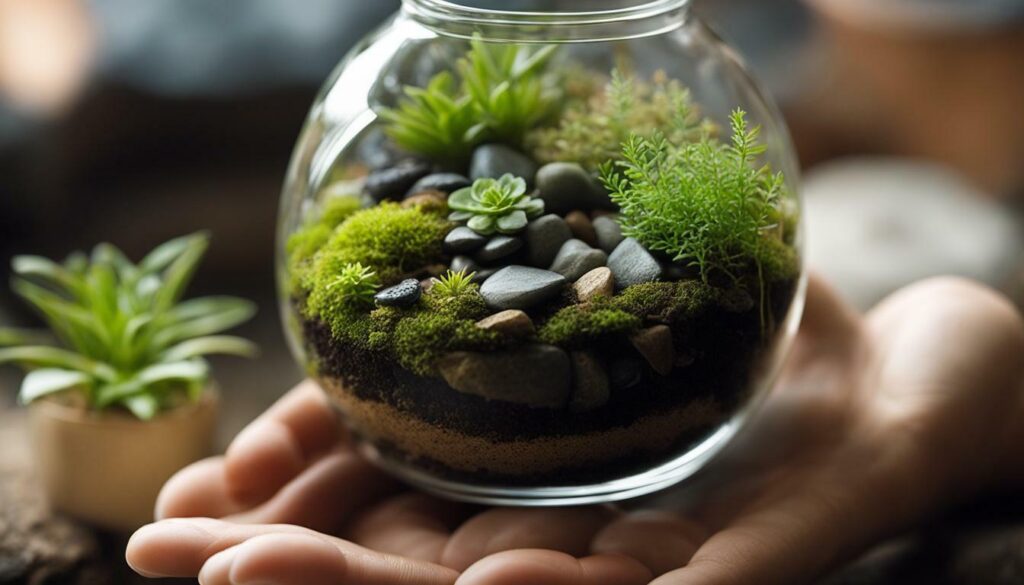
Once you have created these essential layers, your terrarium is ready for planting. Remember to choose tropical plants that can thrive in a closed terrarium environment. With the right layers in place, you’ll create a healthy and beautiful terrarium that brings a touch of nature into your space.
Selecting the Perfect Soil for Your Terrarium Plants
The right soil is crucial for the growth and overall health of your terrarium plants, so it’s important to choose wisely. When selecting soil for your DIY terrarium, consider the specific needs of your plants. Different plants require different types of soil, and using the wrong soil can hinder their growth.
For most terrarium plants, a well-draining soil mix is essential. Excess moisture can cause root rot and other problems, so it’s important to choose soil that allows water to flow through easily. A good option is a mix of regular potting soil and perlite or sand, which helps improve drainage.
If you’re creating a closed terrarium, where the moisture is retained within the container, using a soil mix specifically designed for terrariums can be beneficial. These mixes usually contain ingredients like peat moss, which retains moisture without becoming waterlogged, and organic matter that provides nutrients to the plants.
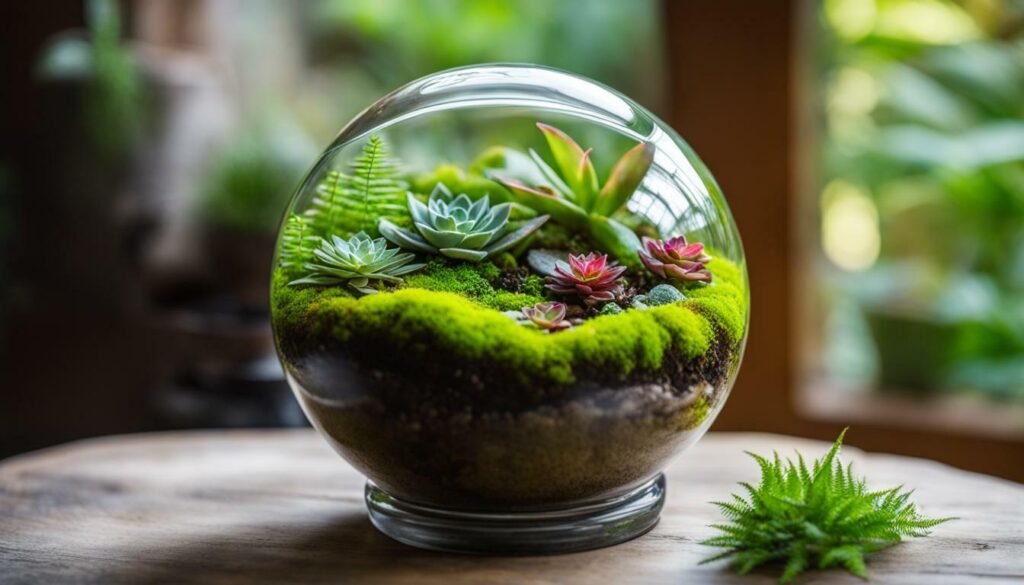
Experimenting with different soil mixes can be part of the fun in creating your DIY terrarium. You can mix and match different components to achieve the ideal texture and drainage for your plants. Just make sure to monitor your terrarium regularly and adjust the watering schedule accordingly.
Soil Selection Tips:
- Research the specific soil requirements of your chosen terrarium plants.
- Avoid using garden soil, as it is often too heavy and compact for terrariums.
- Add perlite or sand to regular potting soil for improved drainage.
- Consider using a pre-made terrarium soil mix for closed terrariums.
By selecting the right soil for your terrarium plants, you can ensure their healthy growth and create a thriving miniature world of greenery. Enjoy the process of experimenting with different soil mixes and watch as your terrarium plants thrive in their new home!
Transferring and Arranging Your Terrarium Plants
Now that you have your terrarium set up with the essential layers and soil, it’s time to transfer and arrange your chosen plants to create a visually appealing miniature garden. Follow these steps to ensure a successful and beautiful arrangement:
- Carefully remove each plant from its original pot, gently shaking off any excess soil. Take care not to damage the roots.
- Create small holes in the soil of your terrarium, spacing them out evenly. The size and number of holes will depend on the size of your plants.
- Place each plant into its designated hole, making sure the roots are covered with soil. If needed, add more soil around the plants to secure them in place.
- Consider the height and growth patterns of your plants as you arrange them. Taller plants can be placed towards the back, while smaller ones can be positioned towards the front for an aesthetically pleasing composition.
Remember to handle the plants with care and avoid overcrowding the terrarium. Leave some space for the plants to grow and breathe. You can also add decorative elements such as small rocks or pebbles to enhance the overall look of your terrarium.
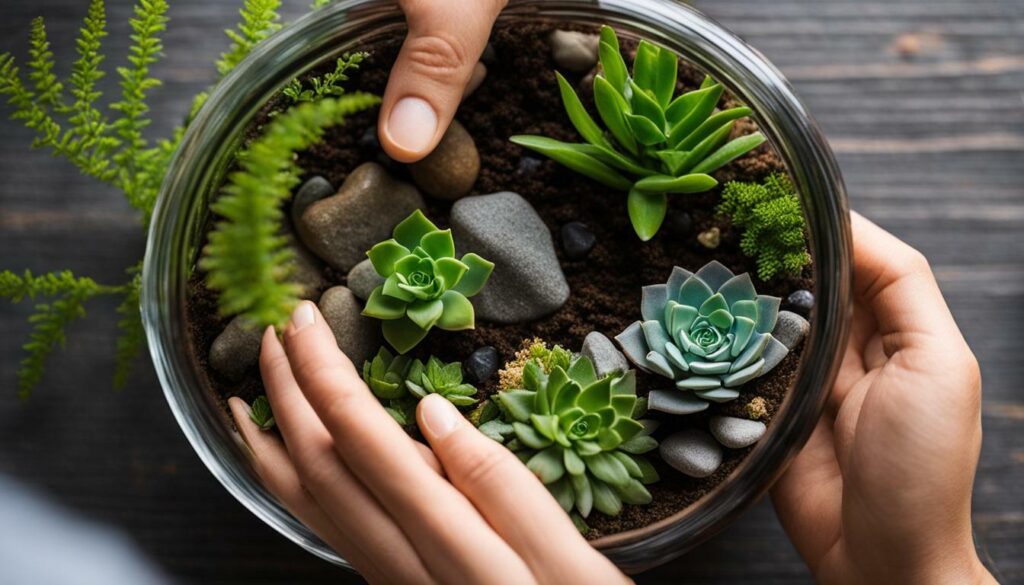
By following these simple steps, you can create a beautiful and personalized terrarium that brings a touch of nature into your home. Experiment with different plant combinations and arrangements to find the perfect design that suits your style and space.
Taking Care of Your Terrarium Plants
Once your terrarium plants are in place, it’s important to provide them with the proper care to ensure their growth and longevity. Here are some essential care tips:
- Water your terrarium sparingly, as the enclosed environment retains moisture. Check the soil regularly and only water when it feels dry to the touch.
- Place your terrarium in a location with bright, indirect sunlight. Avoid exposing it to direct sunlight, as it can lead to overheating and damage to the plants.
- Choose tropical plants that are well-suited for a closed terrarium environment. These plants thrive in high humidity and lower light conditions.
- Monitor the growth of your plants and trim or remove any dead or decaying foliage to maintain a healthy environment for the remaining plants.
With proper care and attention, your DIY terrarium will become a stunning centerpiece that brings a little piece of nature into your home or office space. Enjoy the beauty and tranquility of your very own miniature garden!
Accessorizing Your Terrarium for a Personal Touch
To truly make your DIY terrarium your own, let your imagination run wild and add accessories that reflect your personal style and vision. Whether you prefer a whimsical fairy tale theme or a minimalist modern design, there are endless possibilities for accessorizing your miniature world. From tiny figurines to delicate trinkets, each addition will bring a touch of charm to your terrarium.
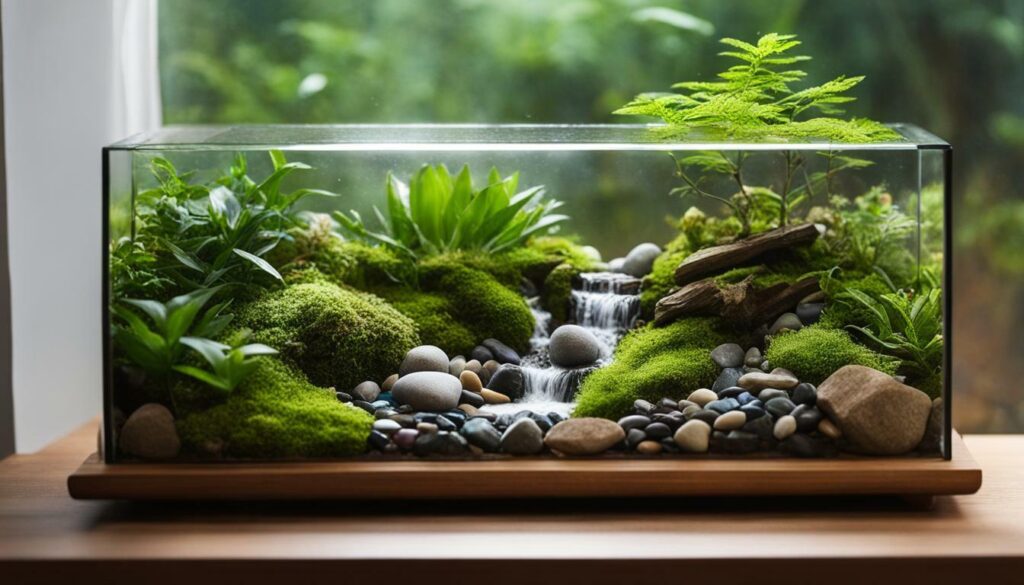
One popular option is to incorporate miniature figurines, such as tiny animals, fairies, or even dinosaurs, to create a whimsical scene within your terrarium. These little characters can add a playful and imaginative element to your miniature world. Consider accessorizing with items that hold personal meaning to you, such as tiny objects that represent your hobbies or interests. By doing so, you’ll create a terrarium that truly reflects your unique personality.
In addition to figurines, you can also include delicate trinkets like small crystals, seashells, or colorful stones. These accessories can add texture, color, and visual interest to your terrarium. Arrange them in a way that complements your plants and creates a visually appealing composition. Experiment with different textures and shapes to create a dynamic and captivating scene.
Creating a Miniature Landscape
If you’re feeling particularly creative, you can take your terrarium to the next level by designing a miniature landscape. Use small rocks or pebbles to create pathways, build tiny fences or walls with twigs or small pieces of wood, and add natural elements like dried moss or dried flowers for an organic touch. This level of detail will transform your terrarium into a captivating work of art.
| Accessories | Description |
|---|---|
| Miniature figurines | Adds a whimsical and imaginative touch to your terrarium |
| Delicate trinkets | Provides texture, color, and visual interest |
| Small crystals, seashells, or colorful stones | Adds a touch of sparkle and uniqueness |
| Miniature landscape elements | Creates a realistic and captivating scene |
Caring for Your Terrarium
Proper care and maintenance are essential for the long-term success of your DIY terrarium, ensuring that your miniature world continues to thrive. Follow these tips to keep your terrarium healthy and vibrant:
- Watering: One of the most important aspects of caring for your terrarium is proper watering. It’s crucial to find the right balance, as overwatering can lead to root rot and under watering can cause your plants to dry out. Check the moisture level of the soil regularly and water only when it feels dry to the touch. Use a spray bottle or a watering can with a narrow spout to avoid overwatering.
- Light requirements: Most terrarium plants thrive in bright, indirect light. Place your terrarium near a window where it can receive plenty of natural light, but avoid direct sunlight as it can scorch the plants and cause them to wilt. If you don’t have access to natural light, you can use fluorescent lights or LED grow lights to provide the necessary illumination.
- Choosing tropical plants: When selecting plants for your terrarium, opt for tropical varieties that can thrive in a closed environment with high humidity. Examples include ferns, mosses, fittonias, and pothos. These plants are well-suited for the moisture levels and limited airflow typically found in terrariums.
- Maintaining humidity: Terrariums create a humid microclimate that helps plants thrive. However, if you notice excessive condensation on the glass or signs of mold or rot, it means that the humidity levels are too high. In such cases, remove the lid or open the container briefly to allow some airflow and balance the moisture levels.
Remember to regularly inspect your terrarium for any signs of pests, such as aphids or mites. If you notice any, take immediate action to prevent them from spreading and damaging your plants. With proper care and attention, your DIY terrarium will become a beautiful and self-sustaining ecosystem, bringing a touch of nature into your home or office.
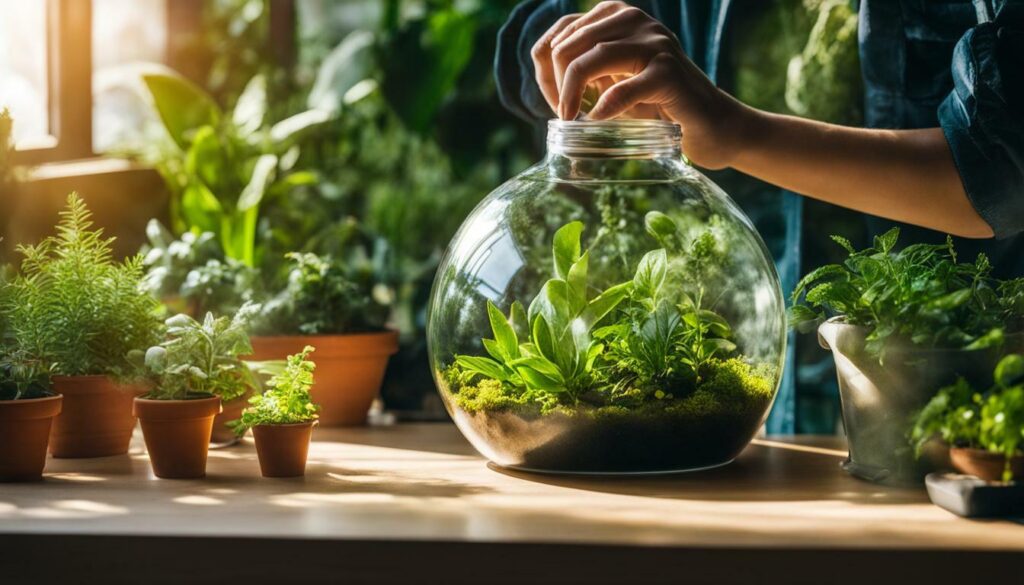
| Tip | Summary |
|---|---|
| 1 | Water terrariums only when the soil feels dry to the touch to avoid overwatering. |
| 2 | Place your terrarium in bright, indirect light to provide the necessary illumination for plant growth. |
| 3 | Choose tropical plants that can thrive in the high humidity and limited airflow of a closed terrarium. |
| 4 | Maintain the humidity levels by adjusting the ventilation and lid of your terrarium as needed. |
Conclusion
DIY terrariums offer a simple and enjoyable way to bring nature into your space, allowing you to create your own miniature green world. Whether you’re a seasoned gardener or just starting out, building a terrarium is a fun and rewarding project that can be customized to suit your style and preferences.
To get started, choose a glass container with a wide opening, ensuring it’s clean and free from any residue. This will provide a clear and unobstructed view of your miniature ecosystem. Create a drainage layer using stones or rocks, followed by a layer of activated charcoal. The stones help to prevent waterlogging, while the charcoal absorbs excess moisture, keeping your terrarium balanced and healthy.
Next, wet some moss and place it on top of the charcoal. This acts as a barrier, preventing water from overflowing and ensuring the right amount of moisture is retained within the terrarium. Add a thick layer of soil that’s suitable for your chosen plants. Different plants have different soil requirements, so make sure to do some research and select the appropriate type.
Once your terrarium is prepared, carefully transfer your chosen plants into the container, arranging them in a way that allows for proper growth and ample space. Add more soil around the plants as needed, ensuring they are securely rooted. Finally, have fun accessorizing your terrarium with figurines or trinkets to create a unique and personalized miniature world.
Remember to choose tropical plants that can thrive in a closed terrarium environment. These plants are accustomed to high humidity and low-light conditions, making them ideal for this type of setup. With proper care and attention to watering and light requirements, your terrarium will flourish and become a beautiful addition to your home or office.
How Can I Incorporate Zen Elements into My DIY Terrarium for a Calming Effect?
Create a peaceful ambience in your DIY terrarium by incorporating elements inspired by explore zen garden terrariums. Use minimalist design, soothing colors, and carefully placed rocks and sand to create a calming effect. Add small statues or figurines to evoke a sense of tranquility and meditation within your terrarium.
FAQ
Can I use any type of glass container for my terrarium?
It is best to choose a glass container with a wide opening for your terrarium. This allows for better airflow and easier access for arranging your plants.
Do I need to clean the glass container before creating my terrarium?
Yes, it is important to clean the glass container thoroughly before starting your terrarium. This helps to prevent the growth of bacteria or mold that could harm your plants.
What is the purpose of the drainage layer in a terrarium?
The drainage layer, made of stones or rocks, allows excess water to flow away from the plant roots, preventing waterlogging and root rot.
Why do I need to use activated charcoal in my terrarium?
Activated charcoal helps to absorb excess moisture and odors in the terrarium, keeping the environment healthy for your plants.
How do I prevent water from overflowing in my terrarium?
Placing wet moss on top of the activated charcoal layer helps to absorb excess water and prevent it from overflowing when you water your terrarium.
What type of soil should I use for my terrarium plants?
It is important to choose a well-draining soil that is appropriate for the specific needs of your plants. Consult with a local nursery or horticulturist for the best soil recommendation for your terrarium.
How do I transfer and arrange my plants in the terrarium?
Gently remove the plants from their containers and loosen the root ball. Create holes in the soil and carefully place the plants, ensuring they have enough space to grow. Add more soil around the plants and gently pat it down to secure them.
Can I add accessories to my terrarium?
Absolutely! Adding accessories such as figurines or trinkets can bring a personal touch to your terrarium, creating your own unique miniature world.
How do I care for my terrarium?
Water your terrarium sparingly, as closed terrariums create a self-sustaining environment. Place your terrarium in a location with indirect sunlight, and choose tropical plants that can thrive in a closed terrarium.

